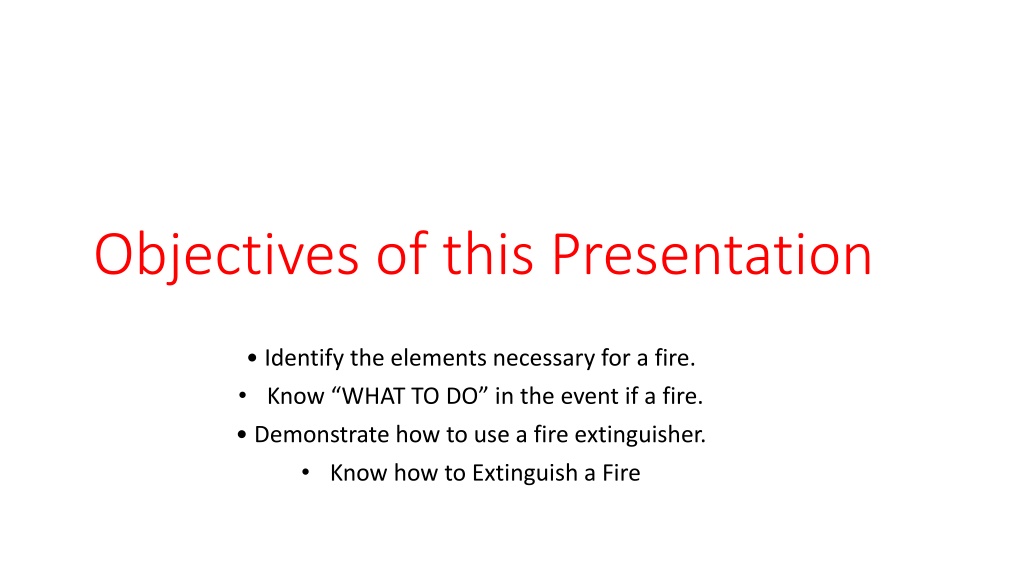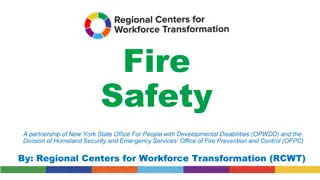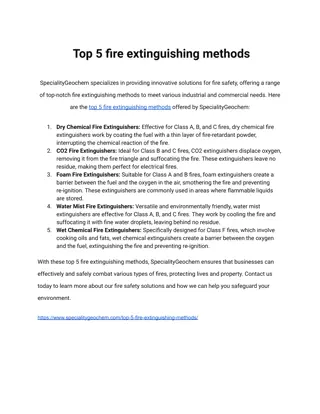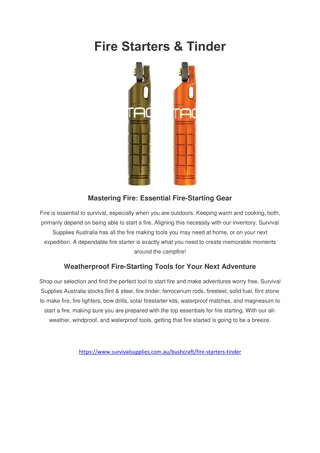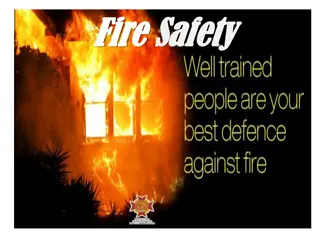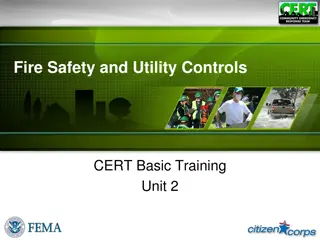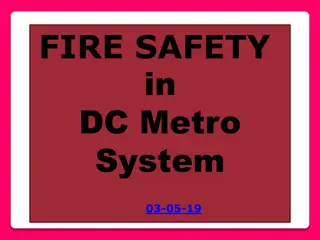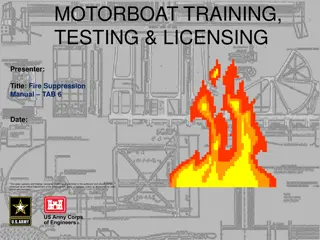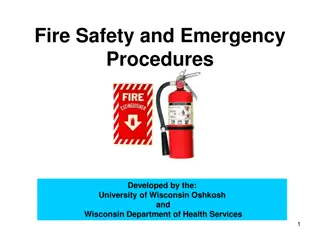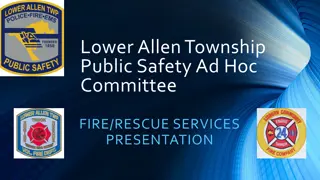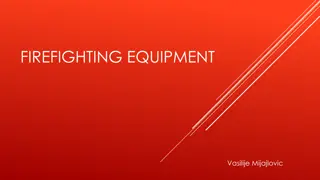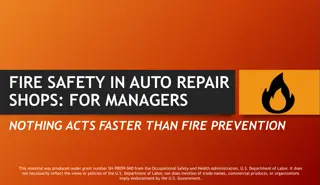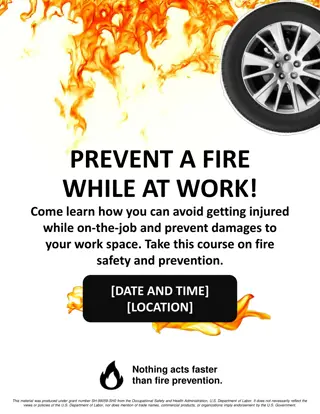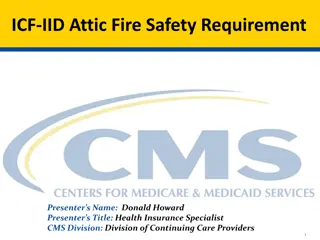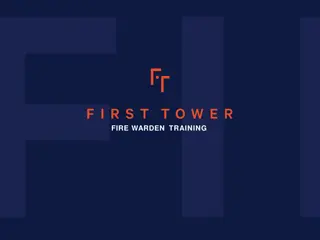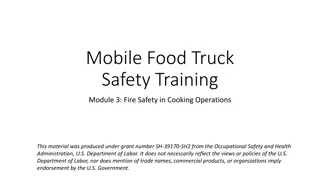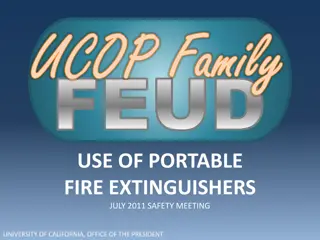Understanding Fire: Elements, Extinguishing Methods, and Safety Measures
Explore the essential elements for a fire to exist, learn about the Fire Triangle, understand the classes of fires, and know which fire extinguisher types are suitable for different fuel sources. Discover practical steps to take in case of a fire emergency and how to safely operate a fire extinguisher. Enhance your knowledge to ensure preparedness and safety in fire-related situations.
Download Presentation

Please find below an Image/Link to download the presentation.
The content on the website is provided AS IS for your information and personal use only. It may not be sold, licensed, or shared on other websites without obtaining consent from the author. Download presentation by click this link. If you encounter any issues during the download, it is possible that the publisher has removed the file from their server.
E N D
Presentation Transcript
Objectives of this Presentation Identify the elements necessary for a fire. Know WHAT TO DO in the event if a fire. Demonstrate how to use a fire extinguisher. Know how to Extinguish a Fire
Elements Necessary for a Fire to exist. Heat: Heat is required to elevate the temperature of a material to its ignition point. Sources of heat include matches, stoves, sparks, etc. Fuel: The fuel for a fire may be a solid (e.g., coal, wood, paper, cloth, hay, etc.), liquid (e.g., gasoline, kerosene, alcohol, paint, cooking oil, etc.), or gas (e.g., propane, natural gas, butane, etc.). The type and quantity of the fuel will determine which method should be used to extinguish the fire. Oxygen: Most fires will burn vigorously in any atmosphere of at least 20 percent oxygen. Without oxygen, most fuels could be heated until entirely vaporized, yet would not burn. Note that these three elements, called the fire triangle, create a chemical exothermic reaction, which is fire. Ask participants to find sources of heat and fuel in the meeting room or building.
The Fire Triangle Fire Triangle Fire requires the following three elements to exist: Heat: Heat is required to elevate the temperature of a material to its ignition point. Sources of heat include matches, stoves, sparks, etc. Fuel: The fuel for a fire may be a solid (e.g., coal, wood, paper, cloth, hay, etc.), liquid (e.g., gasoline, kerosene, alcohol, paint, cooking oil, etc.), or gas (e.g., propane, natural gas, butane, etc.). The type and quantity of the fuel will determine which method should be used to extinguish the fire. Oxygen: Most fires will burn vigorously in any atmosphere of at least 20 percent oxygen. Without oxygen, most fuels could be heated until entirely vaporized, yet would not burn. These three elements, called the fire triangle, create a chemical exothermic reaction, which is fire.
Classes of Fire Knowing the type of fuel helps determine what kind of fire extinguisher to use and how to use it. There are five common classes of fires: Fire Class Fuel A Ordinary combustibles such as paper, cloth, wood, rubber, and many plastics B Flammable liquids (e.g., oils, gasoline) and combustible liquids (e.g., charcoal lighter fluid, kerosene) C Energized electrical equipment (e.g., wiring, motors) when the electricity is turned off, the fire becomes a Class A fire D Combustible metals (e.g., aluminum, magnesium, titanium) F/K Vegetable oils, animal oils, or fats in cooking appliances
Classes of Fire Class A: Burning solids like wood, paper and plastic. Extinguisher types: water, foam, dry powder and wet chemical units. Class B: Burning liquids, such as paraffin, petrol, oil. Extinguisher types: foam, dry powder, CO2 gas. Class C: Burning gases, such as propane, butane, methane. Extinguisher type: dry powder. Class D: Burning metals, such as aluminium, magnesium, titanium etc. Extinguisher type: M28/L2 dry powder. Class E: Fires involving electrical equipment. Extinguisher type: dry powder (but these may leave a residue damaging electrical,Clean Gas systems such as Inergen system work best as they leave no residue and damage to servers and electrical boards. equipment), CO2 gas. Class F/K: Burning cooking oil or fats (kitchen fires) Extinguisher type: wet chemical.
Parts of a Fire Extinguisher Portable fire extinguishers are invaluable for putting out small fires. A well prepared home or workplace will have at least two portable fire extinguishers of the appropriate type for the location. The type of fuel that is burning will determine which resources to select to fight a fire. Most household fires are: A;B;C;D and K
Deciding to Use a Fire Extinguisher: Deciding to Use a Fire Extinguisher: Before attempting to put out a fire with a portable fire extinguisher, you must quickly answer the following questions: Has the Building occupants been Notified? Has someone called the fire department? Are the exit routes Clear and Safely Accessible? Do I have the right type of extinguisher for the type of fire? Is the extinguisher large enough for the fire? Is the fire small and containable?
If your Answer to the above is NO, Then; Leave the building immediately. Shut all doors as you leave to slow the spread of the fire. As soon as you get out of the building, call 911.
If your Answer to the above is YES, Then; To use a fire extinguisher, remember PASS : P PULL. Pull the pin. This will also break the tamper seal. A horn or hose) at the base of the fire. Stand approximately 8 feet away. Note: Do not touch the plastic discharge horn; it may get very cold and may damage skin. S SQUEEZE. Squeeze the handle to release the extinguishing agent. S SWEEP. Sweep from side to side at the base of the fire until it appears to be out. Watch the area. If the fire re- ignites, repeat steps 2 through 4. AIM. Aim low, pointing the extinguisher nozzle (or its
When using a fire extinguisher: Always stand with an exit at your back. Stand several feet away from the fire, moving closer once the fire starts to diminish. Use a slow, sweeping motion and aim the fire extinguisher nozzle at the base of the fire. If possible, use a "buddy system" to have someone back you up or to call for help if something goes wrong. Be sure to watch the area for a while to ensure the fire does not re- ignite.
Fire Safety Rules Always have two ways to exit the fire area. Fires spread much faster than you might think. Always have a backup escape plan in case your main escape route becomes blocked. Look at the door. If air is being sucked under the door or smoke is coming out the top of the door, do not touch the door. Feel closed doors with the back of the hand, working from the bottom of the door up. Do not touch the door handle before feeling the door. If the door is hot, there is fire behind it. Do not enter! Opening the door will feed additional oxygen to the fire. Confine the fire, whenever possible, by closing doors and keeping them closed. Stay low to the ground. Smoke will naturally rise. Keeping low to the ground will provide you with fresher air to breathe. Don t get too close. Stay near the outer range of your extinguisher. If you feel the heat, you are too close. Never turn your back on a fire when backing out. When you have extinguished the fire, carefully check to be sure that it is out, and stays out. Sometimes, what you don t do when suppressing fires is as important as what you should do. Don t forget that your personal safety is your first priority. Don t put it at risk. Don t try to suppress a large fire. If you can t put out the fire in 5 seconds or less, the fire it too large. Get out. Don t enter smoke-filled areas. Suppressing fires in smoke-filled areas requires equipment other than a portable fire extinguisher.
